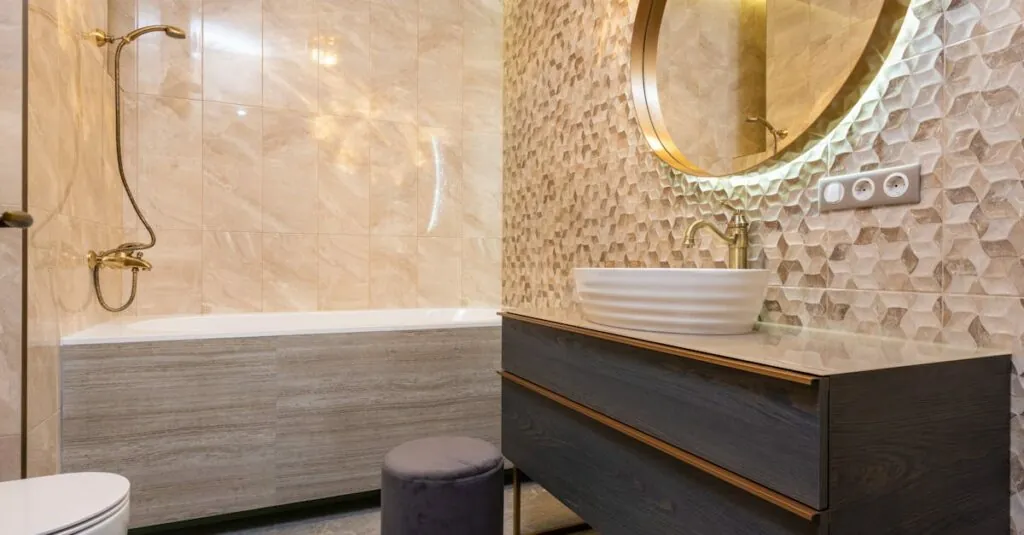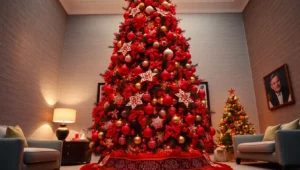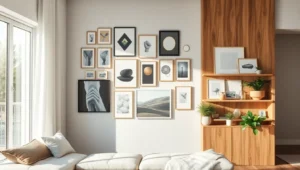Looking to transform a dull room into a vibrant masterpiece? Accent walls are your secret weapon. They’re like the cherry on top of your home decor sundae—adding a pop of personality without overwhelming the entire space. Whether it’s a bold color, a quirky pattern, or even some snazzy wallpaper, an accent wall can turn heads and spark conversations faster than your last dinner party disaster.
Table of Contents
TogglePopular Types of Accent Wall Designs
Accent walls come in various styles that enhance any space’s aesthetic. These popular designs cater to different tastes and preferences, offering flexibility in home decor.
Textured Walls
Textured walls add depth and character to a room. Options include stucco, shiplap, and brick finishes. Each texture provides a unique look and feel, contributing to the overall ambiance. For example, shiplap creates a cozy, farmhouse effect, while exposed brick adds an industrial vibe. Utilizing materials like stone or wood enhances the visual interest and tactile experience. They work well in living rooms, bedrooms, and even offices, making spaces visually striking.
Painted Walls
Painted walls provide limitless color choices for accenting any room. Selecting bold shades like navy blue, emerald green, or deep red creates focal points that draw attention. Softer pastels can evoke a sense of tranquility, fitting for bedrooms or nurseries. Paint techniques such as ombre or geometric patterns can further elevate the design. Mixing contrasting colors on adjacent walls generates a dynamic visual effect. Painted walls function well in any room, transforming standard spaces into personalized environments.
Wallpaper Options
Wallpaper options offer a vast array of patterns and textures for accent walls. Designs can range from floral prints to contemporary geometric shapes. Textured wallpaper provides a three-dimensional effect, adding luxury and sophistication. For instance, metallic wallpapers reflect light beautifully, enhancing the room’s brightness. Peel-and-stick options make application and removal easy, perfect for those who enjoy changing styles frequently. Utilizing wallpaper in dining rooms or bedrooms creates stylish, memorable settings that impress guests.
Materials Used in Accent Wall Designs
Various materials enhance accent wall designs, offering different textures and aesthetics.
Wood
Natural wood brings warmth and elegance to any space. Designers often use reclaimed wood for a rustic feel, while sleek, modern finishes contribute a contemporary touch. Options like shiplap can create a stylish look with depth. Barn doors or wooden panels serve as popular accent features, adding character and charm to rooms.
Stone
Stone provides durability and an organic element to accent walls. A stacked stone finish can create a dramatic focal point, evoking a sense of nature indoors. Choices like slate or granite add a luxurious texture, while natural stone creates a warm ambiance. This material often suits both modern and traditional settings, enhancing overall design cohesion.
Fabric
Fabric offers a soft, tactile approach to accent walls. Textiles like velvet or canvas add comfort and sophistication, acting as unique statement pieces. Wall hangings or upholstered panels create a cozy atmosphere while allowing for endless pattern variations. Utilizing fabric for accent walls can transform spaces, elevating aesthetics with warmth and creativity.
Creating Your Own Accent Wall Designs
Accent walls add character to a room. Designing one requires careful planning and creativity.
Planning and Design Considerations
Consider the room’s purpose when planning an accent wall. Colors influence mood, so choose bold shades like navy or deep green for a dramatic effect. Patterns can also change the room’s perception; stripes can make a space feel taller, while geometric designs bring a modern touch. Measuring the wall accurately ensures the design fits perfectly. Think about lighting as well; natural or artificial light affects how colors appear. Select materials that complement existing décor, enhancing harmony throughout the space. A well-planned approach ensures the wall becomes a stunning focal point.
DIY Tips and Techniques
Gather necessary tools before starting the project. Preparation plays a crucial role in achieving a professional look. Start by cleaning the wall and, if painting, apply painter’s tape for clean edges. Choose high-quality paint or wallpaper for durability. Using a roller can speed up the painting process, while a brush helps with detailed areas. Layer textures with wood, fabric, or stone for added depth; combining materials creates a dynamic visual impact. When installing wallpaper, ensure smooth application by aligning patterns carefully. Following these tips leads to a successful accent wall that transforms the room beautifully.
Conclusion
Accent walls offer a fantastic way to express personal style and elevate home decor. By selecting the right colors patterns and materials homeowners can transform any space into a reflection of their unique taste. Whether opting for a bold paint color or a textured wallpaper accent walls serve as striking focal points that enhance the overall aesthetic.
With endless design possibilities it’s easy to create a captivating environment that sparks conversation and admiration. The DIY approach empowers individuals to take charge of their decor journey ensuring that each accent wall is not just a design choice but a true representation of their personality. Embracing the art of accent walls can lead to a home that feels more inviting and stylish.





